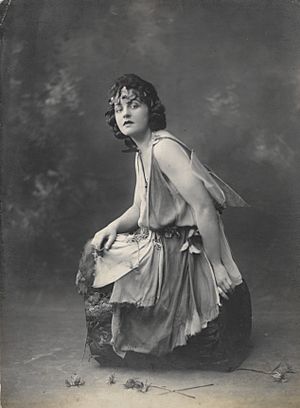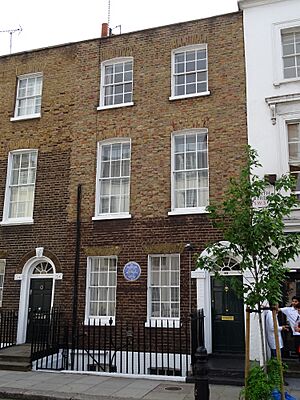P. L. Travers facts for kids
Quick facts for kids
P. L. Travers
|
|
|---|---|

|
|
| Born | Helen Lyndon Goff 9 August 1899 Maryborough, Colony of Queensland |
| Died | 23 April 1996 (aged 96) Chelsea, London, England |
| Resting place | St Mary the Virgin's Church, Twickenham, London |
| Pen name | Pamela Lyndon Travers |
| Occupation |
|
| Nationality | Australian-British |
| Citizenship | Australian, British |
| Genre | children's literature, fantasy |
| Notable works | Mary Poppins book series |
| Children | Camillus Travers Hone |
Pamela Lyndon Travers (born Helen Lyndon Goff; 9 August 1899 – 23 April 1996) was a famous Australian-British writer. She spent most of her life in England. She is best known for creating the magical nanny, Mary Poppins, in her popular book series.
Helen Goff was born in Maryborough, Queensland, Australia. She grew up in the Australian countryside. Later, she went to a boarding school in Sydney. She started writing when she was a teenager. She also worked as an actress for a short time.
When she was 25, she moved to England. She changed her name to Pamela Lyndon Travers. In 1933, she started using the pen name P. L. Travers. This was when she wrote the first of her eight Mary Poppins books.
During World War II, Travers went to New York City. She was working for the British government. Around this time, Walt Disney asked her about making a film based on Mary Poppins. After many years of talking, Walt Disney finally got the rights. The movie Mary Poppins came out in 1964.
Later, a stage musical based on the books and film opened in London in 2004. It then came to Broadway in 2006. In 2013, a film called Saving Mr. Banks was released. It showed how Walt Disney tried to get the film rights from Travers. Emma Thompson played P. L. Travers in this movie. In 2018, a sequel to the original film, Mary Poppins Returns, came out. Emily Blunt played Mary Poppins, helping the Banks family once again.
Contents
Early Life and First Steps in Writing
Helen Lyndon Goff was born on 9 August 1899 in Maryborough, Queensland, Australia. Her mother was Australian. Her father, Travers Robert Goff, worked in a bank. Helen loved reading from a young age. She especially enjoyed fairy tales. She later said she could read by the age of three.
When Helen was three, her family moved to Brisbane. Later, they moved to Allora, Queensland. Helen often played by herself. She developed a strong imagination. She also wrote poetry, but her family did not pay much attention to it. In 1906, she went to school in Allora. Her father passed away in January 1907.
After her father's death, Helen, her mother, and sisters moved to Bowral, New South Wales, in 1907. She attended a local school there. From 1912, she boarded at Normanhurst School in Sydney. At Normanhurst, she discovered her love for theatre. In 1914, she published her first article in the school magazine. She also directed a school concert. The next year, she played a role in a play called A Midsummer Night's Dream. Helen wanted to become a successful actress. Her first job was as a cashier. In 1920, she appeared in her first pantomime. The next year, she joined a Shakespearean acting company in Sydney.
Becoming a Writer
Helen Goff's first acting role was in March 1921. She decided to use the stage name "Pamela Lyndon Travers." She took "Travers" from her father's name. She liked "Pamela" because she thought it sounded pretty with "Travers." She toured New South Wales with the acting group.
While touring New Zealand, Travers met a journalist. He helped her get one of her poems published in The Sun newspaper. Even after leaving New Zealand, Travers kept sending her work to The Sun. She even had her own column called "Pamela Passes." She also had work published in other magazines. She was advised not to pursue journalism. Instead, she focused on poetry. Her poem "Mother Song" was published in March 1922. The Bulletin published her poem "Keening" in March 1923. She became a regular writer for them. In May 1923, she got a job at The Triad magazine. She wrote poetry, journalism, and stories for a women's section. She also published a book of poetry called Bitter Sweet.
Life in England


On 9 February 1924, Travers left Australia for England. She settled in London. She only visited Australia one more time, in the 1960s. For four years, she wrote poetry for the Irish Statesman. She met the poet George William Russell in Ireland in 1925. He was the editor of the Statesman and published some of her poems. Through Russell, Travers met other Irish poets. They helped her learn more about world mythology.
Travers also met interesting thinkers who influenced her. In 1931, she moved to a cottage in Sussex with her friend Madge Burnand. There, in the winter of 1933, she began to write Mary Poppins. During the 1930s, Travers also reviewed plays. She published a book called Moscow Excursion in 1934. Mary Poppins was published that same year and became a huge success. Many sequel books followed.
During World War II, Travers worked for the British government. She spent five years in the United States. She published I Go by Sea, I Go by Land in 1941. She also spent two summers living among the Navajo, Hopi, and Pueblo peoples. She studied their stories and traditions. After the war, Travers moved back to England. She continued writing. She lived at 50 Smith Street in Chelsea, London. A special blue plaque marks her former home there. She returned to the US in 1965. She taught writing at colleges like Radcliffe College and Smith College. She also lectured at Scripps College. She published various works and edited a magazine called Parabola: the Magazine of Myth and Tradition until her death.
The Mary Poppins Books
As early as 1926, Travers wrote a short story called "Mary Poppins and the Match Man." This story introduced the nanny character, Mary Poppins, and Bert the street artist. The children's book Mary Poppins was published in London in 1934. It was Travers's first big writing success. Seven more Mary Poppins books followed. The last one was published in 1988, when Travers was 89 years old.
In a 1977 radio interview, Travers shared that the name "M. Poppins" came from stories she made up for her sisters when she was a child. She even had a book from that time with the name written inside. Her great-aunt, Helen Morehead, is thought to be an inspiration for the character. Her great-aunt used to say, "Spit spot, into bed!"
The Disney Film Version
The musical film adaptation of Mary Poppins was released by Walt Disney Pictures in 1964. It was mainly based on the first book from 1934. It also used parts from the 1935 sequel, Mary Poppins Comes Back. Walt Disney's daughters loved the books when they were young. Disney spent 20 years trying to buy the film rights to Mary Poppins. He even visited Travers at her home in London.
In 1961, Travers flew to Los Angeles. Disney paid for her first-class ticket. She finally agreed to sell the rights. This was partly because she needed money. Travers was an adviser during the film's production. However, she did not like the Disney version of Mary Poppins. She felt the character's tougher side was softened. She also felt mixed about the music. She disliked the use of animation so much that she refused any more film adaptations of her books. She was not invited to the film's big premiere at first. She had to ask a Disney executive to invite her. At the after-party, she loudly said, "Well. The first thing that has to go is the animation sequence." Disney replied, "Pamela, the ship has sailed."
Travers disliked the Disney film and how she felt she was treated. Years later, when producer Cameron Mackintosh wanted to make a British stage musical, she agreed. But she had strict rules. Only British writers could be involved. No one from the original film production could be directly involved. This meant the Sherman Brothers, who wrote songs for the film, could not write new songs for the musical. However, original songs from the 1964 film could be used. These rules were even written in her will.
In a 1977 interview, Travers said about the film, "I've seen it once or twice, and I've learned to live with it. It's glamorous and it's a good film on its own level, but I don't think it is very like my books."
Later Mary Poppins Films
The 2013 movie Saving Mr. Banks tells the story of how the Mary Poppins film was made. It also shows parts of Travers's early life. The movie connects her childhood to the story of Mary Poppins. Emma Thompson played P. L. Travers in this film. Tom Hanks played Walt Disney.
In 2018, 54 years after the first Mary Poppins film, a sequel was released. It was called Mary Poppins Returns. Emily Blunt starred as Mary Poppins. The film takes place 25 years after the first movie. Mary Poppins returns to help Jane and Michael Banks after a family sadness.
Personal Life
Travers did not like to share many details about her personal life. She once said she felt most like "Anonymous as a writer." She wondered if biographies were useful at all.
Travers never married. She had many short relationships with men. For over ten years, she lived with her friend Madge Burnand. They shared a flat in London from 1927 to 1934. Then they moved to a cottage in Sussex. It was there that Travers published the first Mary Poppins book.
When she was 40, Travers adopted a baby boy from Ireland. She named him Camillus Travers. Camillus did not know about his birth parents or that he had siblings until he was 17. His twin brother, Anthony Hone, came to London and knocked on Travers's door. He wanted to see his brother. Travers refused at first. But after an argument with Travers, Camillus went to find his brother. He found him in a pub. Through Camillus, Travers had three grandchildren.
Travers was honored with the Order of the British Empire (OBE) in 1977. This is a special award from the British government. She passed away in London on 23 April 1996, at the age of 96. Even though Travers never fully liked the Disney film version of Mary Poppins, the movie made her very wealthy.
Legacy
In 2018, a crater on the planet Mercury was named "Travers" in her honor. This shows her lasting impact as a writer.
Books by P. L. Travers
Mary Poppins Series
- Mary Poppins, 1934
- Mary Poppins Comes Back, 1935
- Mary Poppins Opens the Door, 1943
- Mary Poppins in the Park, 1952
- Mary Poppins From A to Z, 1963
- Mary Poppins in the Kitchen, 1975
- Mary Poppins in Cherry Tree Lane, 1982
- Mary Poppins and the House Next Door, 1988
Other Books
- I Go By Sea, I Go By Land, 1941
- Aunt Sass, 1941
- Ah Wong, 1943
- Johnny Delaney, 1944
- The Fox at the Manger, 1963
- Friend Monkey, 1972
- Two Pairs of Shoes, 1980
Non-fiction Books
- Moscow Excursion, 1934
- George Ivanovitch Gurdjieff, 1973
- About the Sleeping Beauty, 1975
- What the Bee Knows: Reflections on Myth, Symbol and Story, 1989
See also
 In Spanish: Pamela Lyndon Travers para niños
In Spanish: Pamela Lyndon Travers para niños

